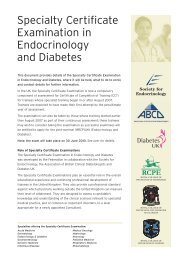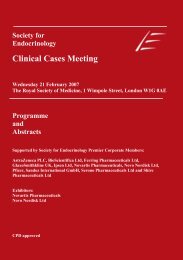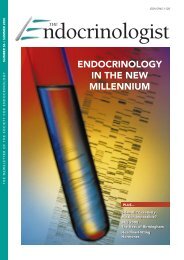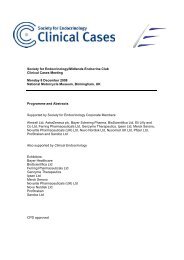Download issue 100 (pdf) - Society for Endocrinology
Download issue 100 (pdf) - Society for Endocrinology
Download issue 100 (pdf) - Society for Endocrinology
Create successful ePaper yourself
Turn your PDF publications into a flip-book with our unique Google optimized e-Paper software.
Can I do it<br />
by myself?<br />
NEW<br />
Genotropin (somatropin, rbe)<br />
pre-fi lled pen<br />
Genotropin<br />
GEN3243C Date of preparation: January 2011<br />
® (somatropin, rbe). Abbreviated Prescribing In<strong>for</strong>mation<br />
Genotropin 5.3 mg Pre-filled pen (GoQuick). Genotropin 12 mg Pre-filled pen.<br />
(GoQuick) Genotropin 5.3 mg Two chamber cartridge. Genotropin 12 mg Two<br />
chamber cartridge. Genotropin MiniQuick 0.2 mg. Genotropin MiniQuick 0.4 mg.<br />
Genotropin MiniQuick 0.6 mg. Genotropin MiniQuick 0.8 mg. Genotropin<br />
MiniQuick 1 mg. Genotropin MiniQuick 1.2 mg. Genotropin MiniQuick 1.4 mg.<br />
Genotropin MiniQuick 1.6 mg. Genotropin MiniQuick 1.8 mg. Genotropin<br />
MiniQuick 2 mg. Please refer to the SmPC be<strong>for</strong>e prescribing Genotropin. Presentation:<br />
Genotropin Pre-filled Pen (GoQuick): Two-chamber cartridge sealed in a disposable<br />
multidose pre-filled pen GoQuick. The cartridges contain either 5.3 mg or 12 mg somatropin<br />
(rbe). Each cartridge also contains 0.3% metacresol as preservative. The 5.3 mg pre-filled pen<br />
GoQuick is colour coded blue. The 12 mg pre-filled pen GoQuick is colour coded purple.<br />
Genotropin Cartridge: Two-chamber cartridge <strong>for</strong> use in a re-useable injection device,<br />
Genotropin pen, or in a reconstitution device. The cartridges contain either 5.3 mg or 12 mg<br />
somatropin (rbe). Each cartridge also contains 0.3% metacresol as preservative. The Genotropin<br />
Pens are colour coded, and must be used with the matching colour coded Genotropin twochamber<br />
cartridge to give the correct dose. The Genotropin Pen 5.3 (blue) must be used with<br />
Genotropin 5.3 mg cartridge (blue). The Genotropin Pen 12 (purple) must be used with<br />
Genotropin 12 mg cartridge (purple). Instruction on reconstitution plus use of devices is supplied<br />
separately as are the Pen and Genotropin Mixer devices and any necessary consumables.<br />
Genotropin MiniQuick: Two compartment cartridge in single dose syringe containing powder<br />
and solvent <strong>for</strong> injection together with an injection needle. Each device contains either 0.2 mg,<br />
0.4 mg, 0.6 mg, 0.8 mg, 1 mg, 1.2 mg, 1.4 mg, 1.6 mg, 1.8 mg or 2 mg somatropin (rbe).<br />
Indications: Children: Treatment of growth disturbance due to insufficient secretion of<br />
growth hormone (growth hormone deficiency, GHD) or associated with gonadal dysgenesis<br />
(Turner Syndrome) or chronic renal insufficiency (CRI) or in short children born Small <strong>for</strong><br />
Gestational Age (SGA) with a birth weight and/or length below –2SD, who failed to show catchup<br />
growth by 4 years of age or later. Prader-Willi syndrome (PWS), <strong>for</strong> improvement of growth<br />
and body composition. The diagnosis of PWS should be confirmed by appropriate genetic testing.<br />
Adults: Replacement therapy in adults with pronounced GH deficiency. Adult onset: Patients<br />
who have severe growth hormone deficiency associated with multiple hormone deficiencies as a<br />
result of known hypothalamic or pituitary pathology and who have at least one known deficiency<br />
of pituitary hormone not being prolactin. Childhood Onset: Patients who were growth hormone<br />
deficient during childhood as a result of congenital, genetic, acquired, or idiopathic causes.<br />
Dosage and Administration: Dose should be personalised <strong>for</strong> each individual. The<br />
subcutaneous injection site should be varied to prevent lipoatrophy. Insufficient Secretion of<br />
GH in children: 0.025–0.035 mg/kg body weight day. Higher doses have been used. Where<br />
childhood onset GHD persists into adolescence, treatment should be continued to achieve full<br />
somatic development (e.g. body composition, bone mass). For monitoring, the attainment of a<br />
normal peak bone mass defined as a T score > −1 (i.e. standardised to average adult peak bone<br />
mass measured by dual energy X-ray absorptiometry taking into account sex and ethnicity) is one<br />
of the therapeutic objectives during the transition period. Prader-Willi Syndrome:<br />
0.035 mg/kg body weight per day. Daily doses of 2.7 mg should not be exceeded. Gonadal<br />
Dysgenesis (Turner Syndrome): 0.045–0.050 mg/kg body weight per day. CRI: A dose<br />
of 0.045–0.050 mg/kg body weight per day. Higher doses can be needed if growth velocity is<br />
too low. Dose correction can be needed after 6 months treatment. Short children born SGA:<br />
0.035 mg/kg body weight per day until final height is reached. GH Deficient Adults: In<br />
patients who continue growth hormone therapy after childhood GHD, the recommended dose to<br />
restart is 0.2–0.5 mg per day. The dose should be gradually increased or decreased according to<br />
individual patient requirements as determined by the IGF-I concentration. In patients with adultonset<br />
GHD, start with low dose, 0.15–0.3 mg/day. The dose should be gradually increased as<br />
determined by the IGF-1 concentration. Clinical response and side effects may guide dose<br />
titration. It is recognised that there are patients with GHD who do not normalise IGF-I levels<br />
Pre-filled<br />
Pre-settable<br />
Predictable<br />
To find out more, please call 0800 521249<br />
despite a good clinical response, and thus do not require dose escalation. The maintenance dose<br />
seldom exceeds 1.0 mg per day. Women (especially those on oral oestrogen) may require higher<br />
doses than men. As normal physiological growth hormone production decreases with age, dose<br />
requirements are reduced. In patients above 60 years, therapy should start with a dose of<br />
0.1– 0.2 mg per day and should be slowly increased according to individual patient requirements.<br />
The minimum effective dose should be used. The maintenance dose in these patients seldom<br />
exceeds 0.5 mg per day. Contra-indications, Warnings etc: Hypersensitivity to the active<br />
substance or to any of the excipients. Any evidence of tumour activity exists. Anti-tumour<br />
treatment must be complete. Genotropin should not be used <strong>for</strong> growth promotion in children<br />
with closed epiphyses. Patients with acute critical illness suffering complications following open<br />
heart surgery, abdominal surgery, multiple accidental trauma, acute respiratory failure or similar<br />
conditions should not be treated with Genotropin. Hypersensitivity to the active substance or to<br />
any of the excipients. Precautions: Diagnosis and therapy should be initiated and monitored by<br />
suitably qualified and experienced doctors. Somatropin may induce insulin sensitivity and in<br />
some patients diabetes mellitus. Patients with diabetes, glucose intolerance, or additional risk<br />
factors <strong>for</strong> diabetes should be monitored closely during somatropin therapy. As thyroid function<br />
may be affected, monitoring of thyroid function should be conducted in all patients. In patients<br />
with hypopituitarism on standard replacement therapy, the potential effect of growth hormone<br />
treatment on thyroid function must be closely monitored. Signs of any relapse of malignant<br />
disease should be monitored. In patients with endocrine disorders, slipped epiphyses of the hip<br />
may occur. In case of severe or recurrent headache, visual problems, nausea and/or vomiting, a<br />
funduscopy <strong>for</strong> papilloedema is recommended as some rare cases of benign intracranial<br />
hypertension have been reported and if appropriate treatment should be discontinued. Leukaemia<br />
has been reported in a small number of growth hormone deficiency patients, some of whom have<br />
been treated with somatropin. However, there is no evidence that leukaemia incidence is<br />
increased in growth hormone recipients without predisposition factors. As with all somatropin<br />
containing products, a small percentage of patients may develop antibodies to GENOTROPIN. The<br />
binding capacity of these antibodies is low and there is no effect on growth rate. Testing <strong>for</strong><br />
antibodies to somatropin should be carried out in any patient with otherwise unexplained lack of<br />
response. Experience in patients above 80 years is limited. Elderly patients may be more<br />
sensitive to the action of Genotropin, and there<strong>for</strong>e may be more prone to develop adverse<br />
reactions. In acute, critically ill adult patients, GH may increase mortality. In CRI, renal function<br />
should be below 50% of normal be<strong>for</strong>e institution of therapy and growth should be followed <strong>for</strong><br />
a year preceding institution of therapy. Conservative treatment <strong>for</strong> renal insufficiency should<br />
have been established and be maintained during therapy. Discontinue GH after renal<br />
transplantation. There have been reports of fatalities associated with the use of growth hormone<br />
in paediatric patients with Prader-Willi syndrome who had one or more of the following risk<br />
factors: severe obesity (those patients exceeding a weight/height of 200%), history of<br />
respiratory impairment or sleep apnoea, or unidentified respiratory infection. Patients with one<br />
or more of these factors may be at increased risk. Be<strong>for</strong>e initiation of treatment with somatropin<br />
in patients with Prader-Willi syndrome, signs <strong>for</strong> upper airway obstruction, sleep apnoea, or<br />
respiratory infections should be assessed. Patients should be monitored <strong>for</strong> signs of respiratory<br />
infections, which should be diagnosed as early as possible and treated aggressively. All patients<br />
with Prader-Willi syndrome should also have effective weight control be<strong>for</strong>e and during growth<br />
hormone treatment. Scoliosis is common in PWS and signs <strong>for</strong> scoliosis should be monitored.<br />
Experience of prolonged therapy in adults and patients with PWS is limited. In short children born<br />
SGA other medical reasons or treatments that could explain growth disturbance should be ruled<br />
out be<strong>for</strong>e starting treatment. Not recommended to initiate treatment in SGA patients near onset<br />
of puberty. Interactions: Concomitant treatment with glucocorticoids may inhibit the growthpromoting<br />
effects of somatropin containing products. There<strong>for</strong>e, patients treated with<br />
glucocorticoids should have their growth monitored carefully to assess the potential impact of<br />
glucocorticoid treatment on growth. The clearance of compounds metabolised by cytochrome<br />
P450 3A4 (e.g. sex steroids, corticosteroids, anticonvulsants and ciclosporin) may be increased<br />
Whatever their concerns, make sure they’re<br />
not about growth hormone therapy<br />
somatropin (rbe)<br />
resulting in lower plasma levels of these compounds. The clinical significance of this is unknown.<br />
In diabetes mellitus, insulin dosage may need adjustment. Somatropin has been reported to<br />
reduce serum cortisol levels, possibly by affecting carrier proteins or by increased hepatic<br />
clearance. The clinical relevance of these findings may be limited. Corticosteroid replacement<br />
therapy should be optimised be<strong>for</strong>e initiation of Genotropin therapy. Pregnancy and<br />
Lactation: Animal studies are insufficient with regard to effects on pregnancy, embryofoetal<br />
development, parturition or postnatal development. There are no clinical studies available on<br />
exposed pregnancies. There<strong>for</strong>e, somatropin containing products are not recommended during<br />
pregnancy and in women of childbearing potential not using contraception. There have been no<br />
clinical studies conducted with somatropin containing products in breast-feeding women. It is not<br />
known whether somatropin is excreted in human milk, but absorption of intact protein from the<br />
infant GI tract is unlikely. There<strong>for</strong>e caution should be exercised when somatropin containing<br />
products are administered to breast-feeding women. Overdosage: Acute overdosage could<br />
lead initially to hypoglycaemia and subsequently to hyperglycaemia and Long-term overdosage<br />
could result in signs and symptoms consistent with the known effects of human growth hormone<br />
excess. Side Effects: In adult patients, common adverse effects related to fluid retention; such<br />
as peripheral oedema, stiffness in the extremities, paraesthesia, arthralgia and myalgia. These<br />
effects are mild to moderate, arise within the first months of treatment and subside spontaneously<br />
or with dose reduction. Formation of antibodies of low binding capacity in approximately 1% of<br />
patients; in vitro chromosome aberrations of unknown clinical significance. Very rare cases<br />
(< 1/10,000) of leukaemia have been reported in GH deficient children treated with somatropin,<br />
but the incidence appears to be similar to that in children without GH deficiency. In Prader-Willi<br />
Syndrome patients treated with somatropin rare cases of sudden death have been reported,<br />
although no causal link has been established. Pharmaceutical Precautions: Keep<br />
Genotropin in the outer carton to protect from light. Be<strong>for</strong>e reconstitution: store in the<br />
refrigerator (2–8ºC). Genotropin Miniquick: Solely <strong>for</strong> ambulatory use, only, the product may be<br />
stored at or below 25ºC by the end user <strong>for</strong> a single period of not more than 6 months. During<br />
and/or at the end of this 6 months period, the product should not be put back in the refrigerator.<br />
Genotropin Cartridge: Storage up to 1 month at or below 25ºC allowed. After reconstitution:<br />
Genotropin Miniquick: Use immediately or within 24 hours. Genotropin Cartridge: Store in a<br />
refrigerator (2ºC–8ºC), do not freeze. Keep the container in the outer carton in order to protect<br />
from light. Use within 4 weeks. Legal Category: CD (Sch 4, Part I), POM. Pack/Basic NHS<br />
Price/PL No: Genotropin 5.3 mg Pre-filled pen (GoQuick) x 1 £122.87 00022/0085.<br />
Genotropin 12 mg Pre-filled pen (GoQuick) x 1 £278.20 00022/0098. Genotropin 5.3 mg Two<br />
chamber cartridge x 1 £122.87 00022/0085. Genotropin 12 mg Two chamber cartridge x 1<br />
£278.20 00022/0098. Genotropin MiniQuick 0.2 mg x 7 £32.46 00022/0186. Genotropin<br />
MiniQuick 0.4 mg x 7 £64.91 00022/0187. Genotropin MiniQuick 0.6 mg x 7 £97.37<br />
00022/0188. Genotropin MiniQuick 0.8 mg x 7 £129.82 00022/0189. Genotropin MiniQuick<br />
1 mg x 7 £162.28 00022/0190. Genotropin MiniQuick 1.2 mg x 7 £194.74 00022/0191.<br />
Genotropin MiniQuick 1.4 mg x 7 £227.19 00022/0192. Genotropin MiniQuick 1.6 mg x 7<br />
£259.65 00022/0193. Genotropin MiniQuick 1.8 mg x 7 £292.11 00022/0194. Genotropin<br />
MiniQuick 2 mg x 7 £324.56 00022/0195. PL Holder: Pharmacia Laboratories Limited,<br />
Ramsgate Road, Sandwich, Kent, CT13 9NJ, UK. Further in<strong>for</strong>mation is available on request from<br />
Medical In<strong>for</strong>mation Department at Pfizer Limited, Walton Oaks, Dorking Road, Tadworth,<br />
Surrey, KT20 7NS, UK. Date of preparation: August 2010. Company reference:<br />
GN20_0<br />
Adverse events should be reported.<br />
Reporting <strong>for</strong>ms and in<strong>for</strong>mation can be found<br />
at www.yellowcard.gov.uk. Adverse events should also<br />
be reported to Pfi zer Medical In<strong>for</strong>mation on 01304 616161.




![The Endocrinologist | Issue 99 [PDF] - Society for Endocrinology](https://img.yumpu.com/48213777/1/184x260/the-endocrinologist-issue-99-pdf-society-for-endocrinology.jpg?quality=85)






![The Endocrinologist | Issue 97 [PDF] - Society for Endocrinology](https://img.yumpu.com/40840065/1/184x260/the-endocrinologist-issue-97-pdf-society-for-endocrinology.jpg?quality=85)





